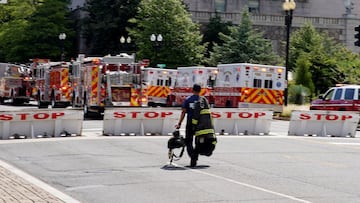OKLAHOMA
April 19, 1995: Oklahoma City bombing | What did Ruby Ridge and Waco have to do with the attack?
It was a tragic day that will stay in the memory for multiple generations, when 168 people lost their lives, including 19 children.

On April 19th, 1995, the city of Oklahoma was rocked to its core by a massive terrorist attack that claimed the lives of 168 people and injured hundreds more. The explosion, which occurred at the Alfred P. Murrah Federal Building, was one of the deadliest acts of domestic terrorism in US history. As the 28th anniversary arrives, we reflect back on what happened and a couple of incidents that may have influenced it.
Who carried out the Oklahoma City bombing?
The bombing, which was carried out by Timothy McVeigh and Terry Nichols, was a calculated act of hatred against the US government. The two men, who were disgruntled with the federal government and believed that it was infringing on their rights, set off a truck bomb that destroyed the entire front of the building and caused extensive damage to surrounding structures.
The immediate aftermath of the bombing was one of chaos and confusion, with emergency responders rushing to the scene to try and rescue survivors and evacuate the area. The sheer scale of the destruction was overwhelming, and it took days for search and rescue teams to comb through the rubble and recover all of the victims. In the weeks and months following the attack, the nation was gripped by a sense of shock and horror at the senseless violence that had been inflicted upon innocent civilians. McVeigh and Nichols were eventually apprehended, tried, and convicted for their crimes, but the scars left by the bombing still lingered in the hearts and minds of those who were affected by it.
Today, the site of the bombing is a memorial to those who lost their lives in the attack, a poignant reminder of the devastating consequences that can result from acts of hatred and violence. The Oklahoma City bombing remains a somber chapter in American history, one that serves as a cautionary tale about the dangers of extremism and the need for vigilance in the face of hatred and intolerance.
The importance of Ruby Ridge and Waco
Two other incidents, one at Ruby Ridge and another at Waco were cited as major influences in the Oklahoma City bombing.
What happened at Ruby Ridge?
Ruby Ridge was a controversial incident that occurred in the United States in 1992. It involved a 11-day siege that took place in Boundary County, Idaho, near the Ruby Ridge area. The standoff began on August 21, 1992, when U.S. Marshals went to arrest Randy Weaver, who was wanted for failing to appear in court on weapons charges. Weaver, a white separatist, lived with his family in a remote cabin in the woods.
The situation quickly escalated when Weaver’s 14-year-old son and a U.S. Marshal were killed in a shootout. The FBI then took over the situation and surrounded the cabin, leading to a standoff that lasted for 11 days. Weaver’s wife, Vicki, and a family friend were also killed during the standoff. Ultimately, Weaver surrendered and was charged with multiple crimes, including murder.
The incident sparked national outrage and led to several investigations, including a congressional hearing. It also brought attention to the controversial tactics used by law enforcement in dealing with armed extremists. The FBI was criticised for its handling of the situation, including the use of excessive force and the rules of engagement that were issued to the agents involved in the siege.
What happened at Waco?
The Waco siege was a deadly confrontation between the United States government and the Branch Davidians, a religious cult led by David Koresh, in 1993. The conflict began when the Bureau of Alcohol, Tobacco, and Firearms (ATF) attempted to execute a search warrant on the group’s compound in Waco, Texas, on suspicions of weapons violations.
The initial raid on February 28, 1993, resulted in a shootout between the Branch Davidians and ATF agents, killing four agents and six Davidians. This event led to a 51-day siege of the compound by the FBI. During the standoff, the FBI used tactics such as loud music and bright lights to try to force the Davidians to surrender, but Koresh refused to come out.
On April 19, 1993, the FBI attempted to end the siege by using tear gas to flush out the remaining members of the group. However, a fire broke out in the compound, resulting in the deaths of 76 people, including 25 children and two pregnant women. The Waco siege has been the subject of controversy, with some people criticizing the government’s handling of the situation and the use of force.
McVeigh influenced?
Timothy McVeigh, who as I stated above was convicted of the Oklahoma City bombing, was known to have been influenced by these incidents, as well as by his own anti-government and extremist beliefs. In fact, as you likely noticed, McVeigh timed the bombing to coincide with the second anniversary of the Waco siege.
While the incidents at Ruby Ridge and Waco did not directly cause the Oklahoma City bombing, they served as powerful symbols of government overreach and abuse of power in the eyes of many extremists. The tragic events of April 19, 1995, stand as a stark reminder of the danger of extremist beliefs and the need for vigilance in countering such ideologies.






